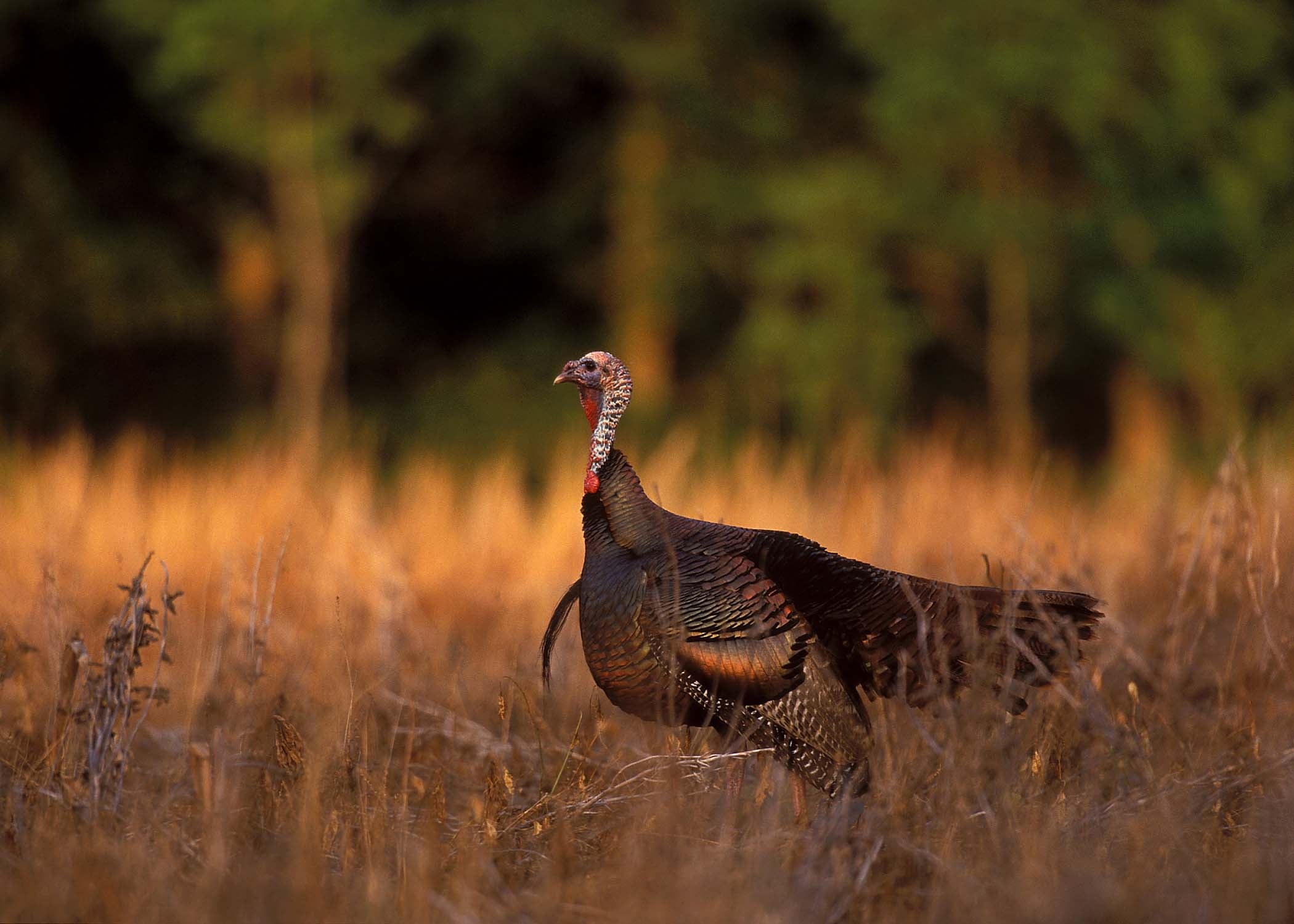SCIENTIFIC NAME:
Meleagris gallapavo silvestris
STATUS:
Breeder. Fairly common in all seasons and regions. Lowest Conservation Concern.
DESCRIPTON:
The eastern wild turkey is one of the largest of the five subspecies of wild turkey that inhabit North America. The adult male, called a gobbler, may measure up to four feet tall and weigh more than 20 pounds. The upper tail covert feathers of the gobbler are tipped with chestnut brown and the long tail feathers are tipped with dark buff or chocolate brown. The breast feathers of the male are tipped in black. The gobbler’s body feathers are characterized by their rich, metallic, and copper/bronze iridescence. His head and neck area is largely featherless with red, white, and blue coloration that is most prominent during the spring mating season. The gobbler is also characterized by the presence of a beard that protrudes from the breast and spurs on the legs. A mature female is called a hen and will weigh between eight and 12 pounds. The hen has an overall brown appearance as compared to a gobbler and the metallic reflections are less brilliant. The breast feathers of the female are brown or buff tipped. The hen’s head and neck are mostly feathered, dull blue in coloration, and smaller than a gobbler’s head and neck.
DISTRIBUTION:
Meleagris gallapavo silvestris is found in hardwood and mixed forests from New England and southern Canada to northern Florida in the east and to Texas, Missouri, Iowa, and Minnesota in the west. The eastern wild turkey is found throughout forested habitats in Alabama from the Appalachian Mountains in the north to the Mobile-Tensaw Delta swamps in the south.
HABITAT:
Preferred habitat includes hardwood and mixed pine-hardwood forestlands interspersed with open areas in both upland and bottomland regions.
FEEDING HABITS:
Adult eastern wild turkeys will primarily seek out mast producing woodlands in the fall and winter to forage on acorns, beechnuts, chinquapins, dogwood berries, hawthorn fruits, and other hard and soft mast on the forest floor. This feeding activity is typified by scratching through the leaf litter with their powerful legs in search of preferred food items. Spring and summer will find adults and hens with broods in open grassy areas foraging on various seed producing plants and insects.
LIFE HISTORY AND ECOLOGY:
In the spring mating season – early March through April – gobblers attract hens through gobbling vocalizations and courtship displays such as strutting and drumming. After mating, a hen will seek out a nesting site on the ground that is usually surrounded by moderately woody vegetation that conceals the nest from predators. The hen will lay a clutch of 10 to 12 eggs during a two week period, usually laying one egg per day and incubating the clutch for about 28 days before hatching. A newly-hatched brood of young, called poults, will leave the nest site with the hen in 12 to 24 hours post-hatch and travel to a grassy opening to feed on protein rich insects. Poult survival from hatching to the fall season is about 35 percent with losses resulting from predation and exposure to inclement weather. Broods that survive to the fall will form mixed winter flocks and remain together until spring dispersal.
REFERENCES:
Dickson, J.. 1992. The Wild Turkey. Biology and Management. Stackpole Books, Mechanicsburg, PA. 455 pp.
Author:
Steve Barnett, Wildlife Biologist, Division of Wildlife and Freshwater Fisheries
Downloadable book Alabama Wild Turkey
Articles:
Subspecies of North American Wild Turkey
Dos and Don'ts of Safe Turkey Hunting
Managing Woodlands for Wild Turkeys
Managing for Three Inch Turkeys






